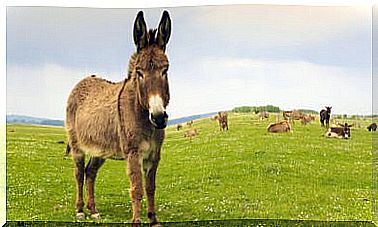Keeping Elephants In Captivity

The maintenance and breeding of wild animals by man has been a common practice for generations. This is the case of captive elephants, used as work animals in African and Asian countries, and as entertainment in Western countries.
Particularities of keeping elephants in captivity
About a third of Asian elephants live in captivity and about 1,000 African elephants worldwide. This is because they have been used, since ancient times, as draft and leisure animals.

The behaviors that appear during life in captivity do not always correspond to the nature of the animal. But, in general, they try to reproduce the ideal conditions to facilitate their survival.
Formation of social groups
In more advanced countries, an attempt is always made to keep elephants in captivity while respecting social structures. With this, the almost optimal development of the ethological behavior of these animals is allowed.
Broadly speaking, the groups, in captivity, are usually smaller, made up of unrelated animals. In fact, we can find groups in which Asian and African elephants are mixed. In any case, the presence of males and young is occasional.
The females are grouped in families of two or more individuals. And since the birth of young is not usually common in captivity, small elephants are not usually present in these groups.

Matriarchs, as such, do not usually exist in captivity. But matriarchy continues to shape the creation of elephant societies. Normally, the dominant female is dominant because of her size and temperament.
Males are physically separated from females and other male specimens. But they are allowed to always maintain visual, auditory and olfactory contact.
Elephants in captivity: keeping African and Asian species together
Given the intention of keeping the animals in a social environment that is as natural as possible, the grouping of the two species together is becoming less common. In addition, the possibility of disease transmission between species is another dissuasive reason.
Difficulties in assembling elephants in captivity
Although elephants in captivity do not usually associate based on kinship, they do have other social behaviors similar to those they would have in the wild. For example, the production and response to chemical signals and vocalizations of other individuals.

Zoo managers want healthy and easy-to-handle animals in their facilities, especially considering that continuous human presence and a certain degree of interaction are expected.
What challenges are there when keeping elephants in a zoo?
The main challenge is the ability of animals to develop normal social behaviors, even more so in a completely artificial and humanized environment.

It is also true that some elephants in the wild encounter similar challenges when sharing territory with human populations. Although in these cases the interactions are less numerous and more varied, some can even be dangerous.
What happens when an elephant enters a zoo for the first time?
The animal must have time to adapt to the new facilities and company. This time is usually tinged with peaks of stress and unusual behaviors. But, given its calm nature, adaptation is usually possible in the vast majority of cases.
The best we can do to facilitate adaptation is to help ourselves with environmental enrichment that emulates the activities that the elephant would do in the wild.
 It might interest you …
It might interest you …
Main image source | http://bebesdelreinoanimal.blogspot.com









